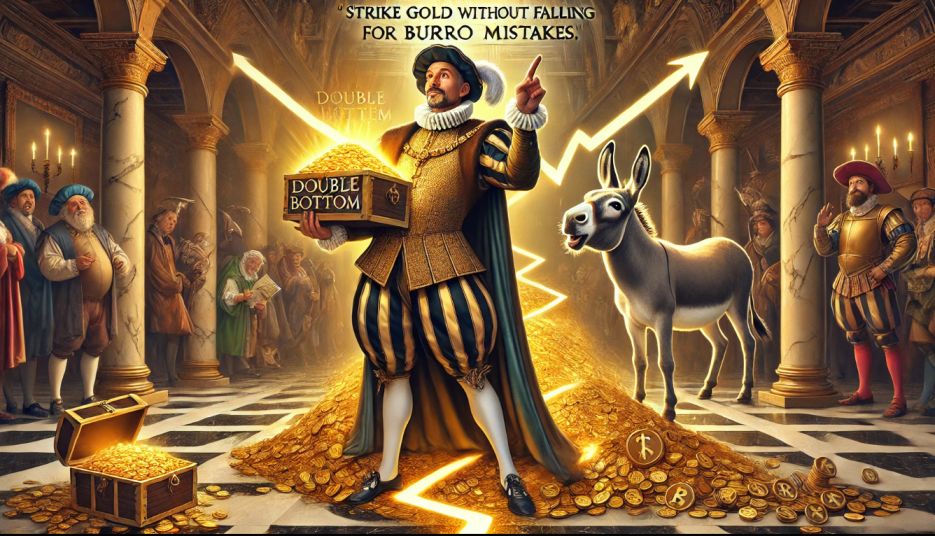
Double Bottom: Strike Gold, Avoid the Pitfalls
April 21, 2025
In high-stakes stock trading, patterns are both the key and the trap—cryptic symbols that hint at treasure yet obscure danger. Among these, the double bottom stands as a particularly enticing beacon, offering untold riches to the sharp-eyed while luring the unwary into financial quicksand.
The double bottom pattern is like a treasure map—but it’s all too easy to mistake a fake for the real thing. When wielded correctly, it can transform you into a market marauder, reaping profits like a seasoned bandit. Misread or misused, it’s the equivalent of a clueless mule plodding into disaster.
What Exactly Is a Double Bottom?
Imagine a stock price chart sculpting the letter “W.” That’s your double bottom—two troughs separated by a peak, signalling a bullish reversal. In the simplest terms: after a heavy sell-off, the price drops, bounces back, then drops again—hovering just above the initial low—before making a final move upwards. This structure suggests that the selling pressure has exhausted itself, creating an opening for buyers to take charge.
The key to spotting this? Psychological dynamics. It’s a battle of sentiment—fear and doubt clash with the desire for upward momentum. The second trough represents the last gasp of bearish control before the bulls take over.
Making Out Like a Bandit: When the Double Bottom Works
Here’s the trick: The double bottom is not about spotting the pattern—it’s about confirming it. Apple Inc.’s mid-2016 stock action serves as a textbook example. In this case, the stock hit a low near $90 twice, both times bouncing higher. But here’s where the winners separated themselves from the losers: confirmation.
The breakout above the resistance level, coupled with strong volume, validated the reversal. Traders who waited for this clear signal locked in gains as Apple surged. Those who jumped in too early, before confirmation, found themselves stuck in the mud, outpaced by the market’s next move.
Avoiding the Pitfalls
The pattern may seem simple, but don’t mistake the double bottom’s allure for certainty. Like all things in the market, it’s more about psychology than simple chart patterns. The key is waiting for the confirmation—a move above resistance, accompanied by volume, that truly marks the end of the downward trend. Without this, you’re simply guessing.
The pitfall lies in acting on hope rather than evidence. The market’s rhythm is as erratic as it is revealing—don’t rush in. Wait for the market to confirm what you already know: that the tide of selling has truly turned. Only then can you strike, like a bandit, at the perfect moment.
The Burro’s Folly: Falling for False Bottoms
Not every “W” is gold. Sometimes, it’s a trap—an illusion that leads the naive straight into the jaws of financial ruin. Take General Electric in 2018. The stock dipped to $13 twice, mimicking a double bottom. Traders rushed in, eager to ride the wave. But instead of rebounding, GE plunged deeper, shattering the illusion of support and proving the pattern a mirage.
Here’s the stark truth:
Weak Fundamentals: GE’s financial outlook was sinking fast. Bearish Sentiment: The market was dominated by pessimism, rendering any reversal hopeful at best. Volume Void: There was no volume surge to confirm the breakout. Without this, it’s just noise.
The lesson: context is everything. A double bottom without it is just a false flag, like a map without a destination.
Tools of the Trade: Confirming the Double Bottom
To avoid the burro’s fate, we need tools—indicators that separate gold from fool’s gold.
MACD (Moving Average Convergence Divergence): This tells you whether momentum is on your side. A bullish divergence (price drops, but MACD rises) is the green light you want. Think of MACD as your smart ally, always ahead of the curve, warning you when a trend is about to change.
RSI (Relative Strength Index): RSI gauges whether a stock is oversold (below 30) or overbought (above 70). If it’s oversold, it’s a signal to buy. RSI is your weathered guide, reading the mood of the herd, telling you when to act before the crowd catches on.
Use these indicators in conjunction with the double bottom for a clearer picture. Ignore them, and you’re trading blind.
Mass Psychology: The Engine Behind the Pattern
At its heart, the double bottom isn’t just a chart—it’s a psychological showdown. Every trough and peak is a battle between fear and greed. To unlock its true potential, you need to understand the emotions at play.
Take the 2008 financial crisis. The S&P 500 formed a double bottom from November 2008 to March 2009, with each trough reflecting a moment of utter despair. Traders who recognized the emotional tide—fear turning into cautious optimism—saw the turning point. They didn’t just see the pattern; they understood it.
The result? The birth of a bull market that lasted for over a decade. Recognise the emotional shift, and you’re not just reading charts—you’re predicting the next phase.
The Three Laws of Double Bottom Survival
To avoid the pitfalls of the unprepared and claim your bandit’s bounty, follow these cardinal rules:
- Wait for Confirmation:
- To validate the pattern, a breakout above the resistance level with accompanying volume must occur. Premature entry is a surefire ticket to the poorhouse.
- Check the Fundamentals:
- A stock with weak fundamentals is like a ship with a leaky hull. Even if the chart pattern is perfect, it’s unlikely to stay afloat.
- Respect the Market Context:
- Broader market trends matter. Even the strongest patterns are often doomed to fail in a bear market. Trade with the tide, not against it.
Making Double Bottoms Work in Modern Markets
Today’s stock market is more dynamic than ever, with algos and quants prowling the waters. But the principles of the double bottom remain timeless, rooted in the unchanging nature of human behaviour.
- Leverage Technology: Use modern trading platforms to set alerts for potential patterns. Automate what you can, but keep your wits sharp.
- Embrace Risk Management: Place stop-loss orders below the second trough. This way, even if the pattern fails, you’ll live to trade another day.
- Stay Humble: Every trader gets duped sometimes. The key is to learn, adapt, and come back wiser.
Conclusion: The Double Bottom—Glory or Ruin
The double bottom isn’t just a pattern—it’s a battleground. A high-stakes crucible where the bold forge their fortunes and the reckless meet their ruin. When executed with precision, it becomes a master key to unlock the market’s wealth. But misread or mishandled, it’s a trapdoor to financial oblivion.
To emerge victorious, traders must transcend the role of mere technicians. They must become strategists—ruthless and calculating. Mastering the double bottom demands unflinching discipline, a balance of cold logic and sharp psychological insight. It’s not enough to recognise the pattern; you must read its soul, understand its risks, and respect its power to deceive, even the seasoned veterans.
This is no playground—it’s a high-stakes arena, where intellect, emotion, and execution collide. Only those with the courage to confront their fears, the cunning to outwit the herd, and the discipline to remain steadfast can transform this pattern from a simple chart formation into a crown of triumph.
The double bottom offers no guarantees—it gives challenges. It tests your resolve. Will you rise to meet them, or will you stumble into their pitfalls? The market doesn’t wait, and neither should you. Fortune favours the fearless.












